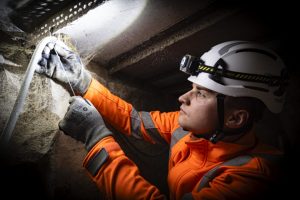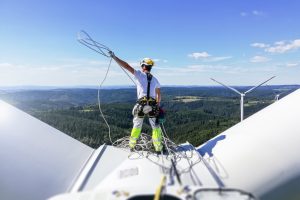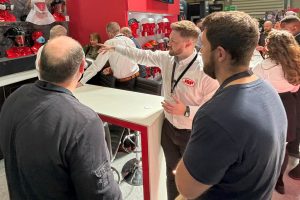It’s your neck on the line
One of the most essential ways of keeping people safe in the workplace is with above-the-neck PPE, so Matthew Judson explores what’s new in the market.
The term above-the-neck includes all types of safety helmets, safety eyewear, ear and respiratory protection, all of which are constantly being innovated and updated by good manufacturers.
The market is seeing several significant advances. One important trend in above-the-neck PPE is improving wearer safety by integration to give all-in-one head, ear and eye protection. In safety eyewear we are seeing further integration with other devices, such as safety helmets and respiratory products. The ability for eyewear to be fixed to helmets or respiratory products gives good compatibility, removing the risk that one or other won’t work when they are used together.
An intensifying emphasis on the health of the whole person is also being seen. For example, the reclassification of hearing protection from Category II (Intermediate) to Category III (Complex) under the new PPE Regulation 2016/425 that replaced the old PPE Directive (89/686/EEC) and came into force in the UK in April 2018, means that hearing protection must now be treated as seriously as protection from asbestos, ionising radiation, electric shocks, falls from height and drowning.
It demonstrates a desire not only to protect the immediate, but also the long-term, health of the individual. For this reason, respiratory protection is also classified as Category III.
Manufacturers are becoming more concerned about health, and long-latency injuries, than fatalities. For instance, progressive hearing damage may occur over a long period of time that the worker does not know about until it’s too late to do anything about it. They will have lost their hearing for the rest of their lives.
The new EU PPE Regulation ensures that safety products conform to the latest performance standards and are more reliable. It may lead to a reduction in counterfeiting, as good products are much more difficult to counterfeit, so reducing substandard products available on the market.
Another development is passive safety, with reflective strips on helmets, brighter coloured helmets, and ear defenders with additional features to make them more visible to everyone else and therefore safer.
And more people are taking increased interest in what a product does and how to use it, being more conspicuous and visible to other people, and understanding the compatibility of above-the-neck PPE. Compatibility is not just about fitting, but PPE working together.
Fitting together and being compatible are not the same thing, since things that fit are not necessarily compatible in performance. To solve this dilemma, it is best to buy PPE from the same manufacturer, who has designed the products to work together.
Drivers of key trends
New developments in the above-the-neck PPE market are primarily driven by legislation. The new PPE Regulation places greater emphasis on the compatibility of above-the-neck products, making sure they truly work together.
Another factor driving progress in above-the-neck PPE is that a growing number of people are working in increasingly hazardous environments, intensifying the risks of harm. For one thing, hand tools are much more powerful these days, and the escalating amount of automation in the workplace is also a factor.
For example, the snowballing use of robots in industrial environments can pose a danger as they can swing around and cause injury with a lot more force than a human being.
Construction is another industry where hazards are increasing. The increasing redevelopment of brownfield sites is entailing a great deal of demolition, a very skilled job that can be dangerous to workers and those around the site.
Big infrastructure projects with long lead times such as the construction of Hinkley Point nuclear power station, a 10-year project, have led to a need for safety products to last a long time. In the past, numerous subcontractors were looking at short-term employment, so they didn’t need long-term products.
With long lead time projects, it becomes more beneficial to provide and use products that will last, even though they may have been considered too expensive in the past. These days, when looked at over a longer term, they have become more affordable.
Head protection
We are seeing a move away from the basic, bog-standard EN397 helmet to helmets that do more and give a better level of protection. Helmets to climbing standard are becoming increasingly popular, as they are more lightweight than the more expensive, top level, 14052 high-performance helmet, which is sometimes perceived as too uncomfortable to wear.
The climbing type of helmet, while heavier than the EN397, looks sportier and more stylish, so wearers are getting a high level of protection without having to buy a 14052 helmet. Looking good in their PPE is increasingly becoming more important to the end user.
Another climbing helmet benefit is that it offers some side impact protection, the need for which people are becoming more aware of. Manufacturers and employers have been very good at ensuring safe working practices are carried out and making sure things don’t fall, but it’s now more likely that workers may walk into objects or suffer unexpected hits from the side rather than from above.
Respiratory
Every aspect of respiratory PPE is moving towards a higher level of protection. While an Assigned Protection Factor (the level of protection a wearer can reasonably expect) of 4 or 10 used to be acceptable, the demand is now for more protection, even up to factor 20.
The same holds true for FFP3 dust masks and half masks with filters. And the newer, more affordable, powered air respirators with a protection factor of 40 are beginning to become more popular.
Eye protection
Innovative anti-fog coatings on safety eyewear is a trend the PPE market has been seeing for a while. Fogging caused by differences in temperature has been a big problem, leading to workers removing their specs or goggles and therefore leaving themselves open to potential eye injury. Fashion is also important as wearers want to look good in their specs.
Hearing protection
A new factor is that workers are beginning to monitor the hazards they may be exposed to in order to select the appropriate type of ear protection for the situation.
Whereas in the past high, medium and low-protection ear defenders were available and most people just went for the medium one, they are now actually measuring the noise being generated before making their choice.
This increased monitoring is driven by employers and employees becoming more aware of risk through education about the risks they are exposed to by bodies such as the HSE, ROSPA, IOSH and PPE manufacturers. Improved awareness of risk means manufacturers can provide workers with the right PPE for the hazard that does not either over- or under-protect.
Smart PPE
There is intensified interest in intelligent PPE, which may include sensors such as man-down or proximity sensors. Powered respirators, for instance, can now sense how hard someone is working and therefore how hard their respirator is working by measuring the particles going into the respirator.
Smart PPE can also talk to people so that site managers can know a worker’s location. Smart PPE is not directly making workers safer but making them safer indirectly, as they are able to be less distracted and more aware of their surroundings.
Respirators and ear defenders can sense what the wearer is doing and change performance parameters, monitoring the way they perform to offer the best level of protection. Ear defenders are able to listen to ambient noise and counteract it.
Training
The provision of employer and employee training in understanding the various features of products, what they can and cannot do, and selecting the correct PPE for the job, is becoming more important and will continue to drive the above-the-neck market. The realisation that you can't just give workers a piece of PPE and tell them to get on with it is growing. Manufacturers are spending a large amount of money and time on this training.
Companies are always looking for cost savings, but the best cost saving is training people on how and why to select, use and look after the product. It can only be a good thing. If people understand the product, they are more likely to look after it.
Future investment
A lot of investment is currently being put by manufacturers into PPE add-ons and extra features, such as respiratory and noise monitoring and measurement sensors, and helmet-mounted devices that sense proximity to machinery. There has been an explosion of head-mounted lights, needed as more and more construction sites are working 24-hours a day.
As far as PPE such as basic helmets and goggles are concerned, manufacturers are spending money and intellectual time on improving materials and making them lighter weight and more comfortable to wear.
All in all, safety products must be compatible in today’s environment. For this, all-in-one units are the best.
Matthew Judson is director, respiratory and technical support at JSP. For more information, visit www.jspsafety.com
HSM publishes a weekly eNewsletter, delivering a carefully chosen selection of the latest stories straight to your inbox.
Subscribe here





